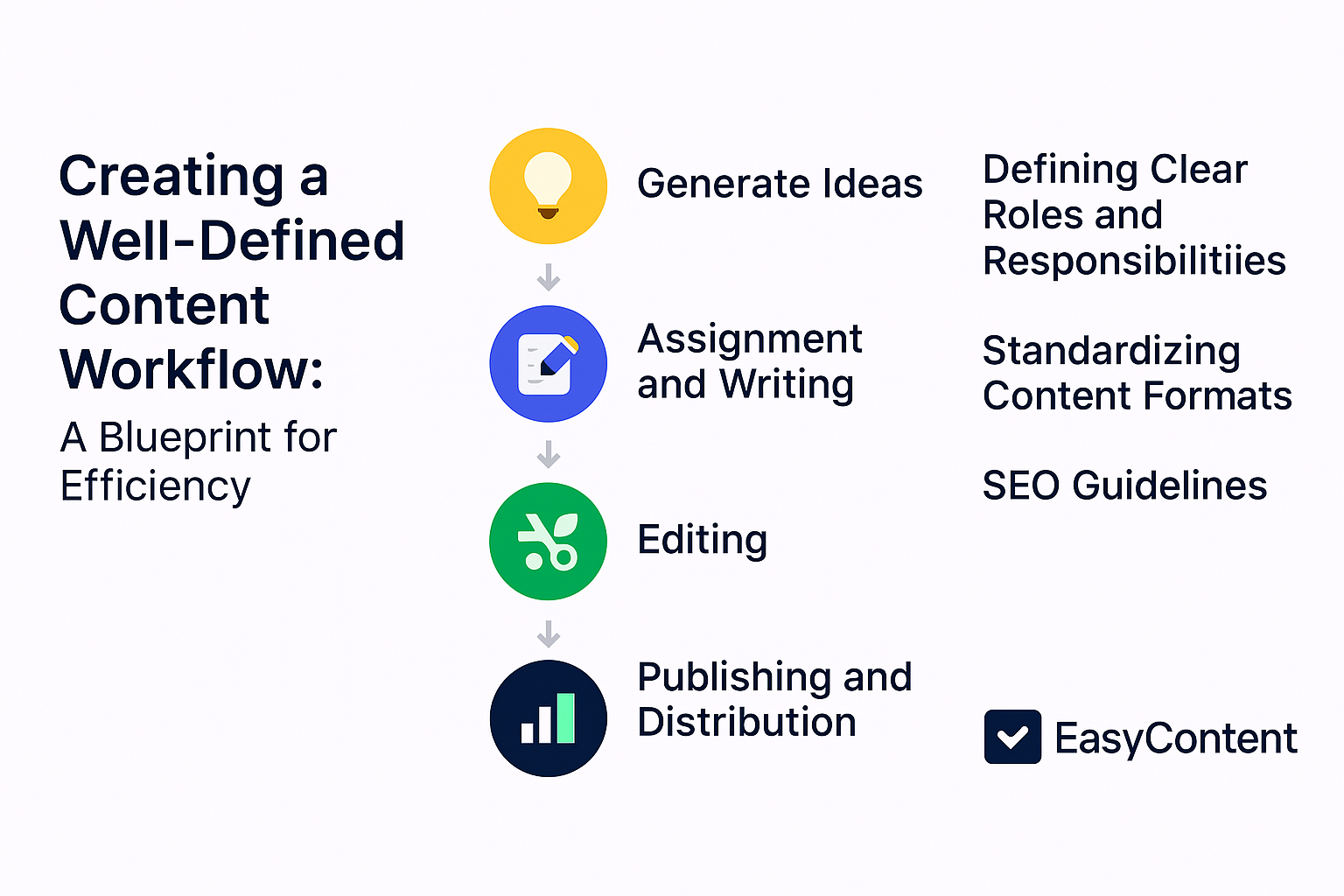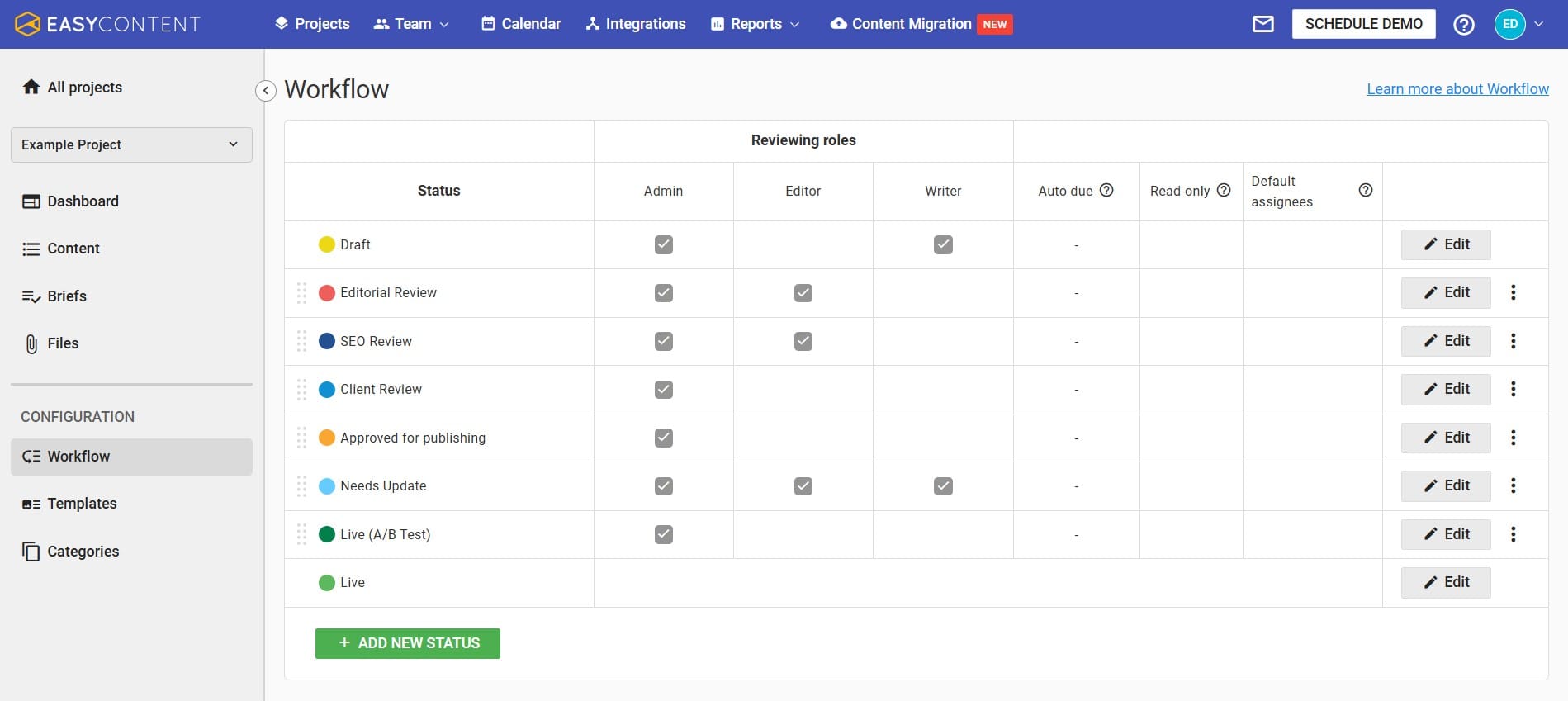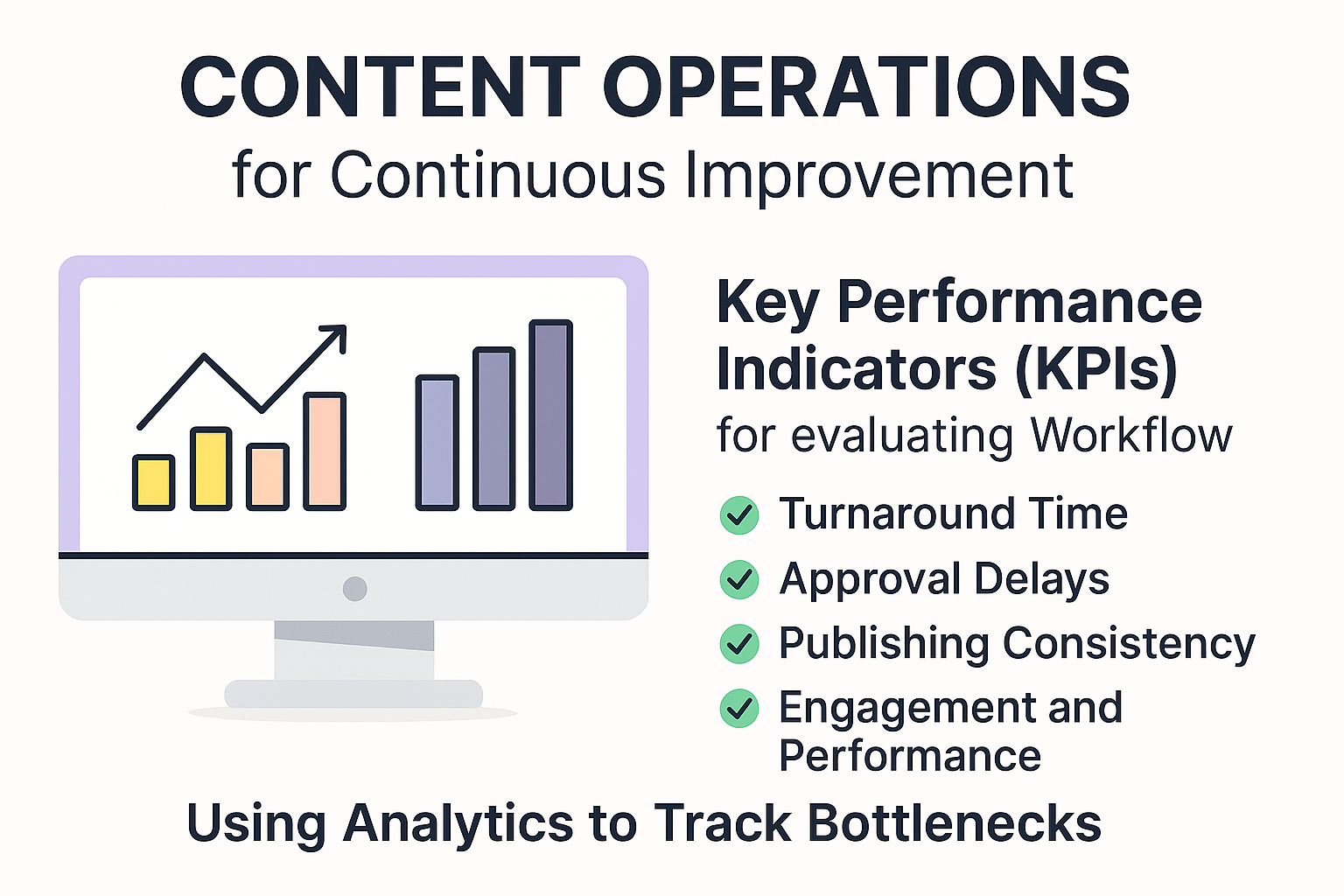How to Streamline Content Operations and Workflows for Maximum Efficiency
Disorganized workflows and manual processes slow content teams down. The solution? Automation, clear workflows, and centralization. EasyContent helps teams streamline operations, speed up approvals, and publish content without stress or chaos.

Managing content now is more difficult than just drafting an article and publishing it. Content managers are under continual pressure to keep things orderly, on schedule, and high-quality as companies create more than ever—across blogs, social media, email marketing, and beyond. But the difficulties also expand along with content activities.
Content teams find workflow inefficiencies to be one of their main irritations. Often slowing everything down are scattered procedures, limitless permission loops, and version control problems. Have you ever found yourself combing many email conversations looking for the "final" form of a blog post? Alternatively, you may have gone through the aggravation of waiting days for comments just to find contradicting views among several stakeholders. These obstacles affect performance and delay material dissemination, therefore wasting not just time.
Another major issue is missed deadlines. Tasks can fall through the gaps of an unclear system. Last week's expected launch blog article could still be locked in revisions. A social media campaign can be delayed if someone neglected to approve the copy. These little inefficiencies compound to make it more difficult for teams to keep consistency and grow their activities.
And what then is the cure? Automation and approaches grounded upon structure. Instead of juggling many technologies, content managers need a disciplined framework that streamlines every stage—from inspiration to approval to publishing. And systems such as EasyContent really help in this regard.
EasyContent is a workflow powerhouse meant to assist content teams keep on top of tasks, automate approvals, and maintain content consistency—not simply another tool for content storage. You may build up automatic approval systems instead of hunting individuals for comments. You receive a clear dashboard with work allocations and deadlines instead of wondering who is accountable for what. Furthermore, built-in version control removes the need for final draft speculation.
This post will walk over how content managers could employ organized processes, automation, and elimination of inefficiencies to maximize production. Whether you are managing a small team or a major content production, these techniques will enable you to keep ahead, maintain team alignment, and produce excellent material free from anarchy.
Key Takeaways
Identifying Bottlenecks in Your Content Workflow
Though in practice many teams battle with bottlenecks that hold things down, content development should go without any problems. You know the sensation—searching for comments from several individuals, attempting to ascertain which version of a document is the most current, or waiting for approvals that never seem to come. These inefficiencies damage team productivity and postpone content delivery, therefore wasting not just time.
Common Roadblocks That Disrupt Workflow
One of the biggest challenges in content management is slow approvals. If content is stuck in endless review loops with multiple stakeholders, projects get delayed, leading to missed deadlines. Maybe a blog post sits in the “waiting for approval” stage for days (or weeks), only to receive last-minute changes that require a complete rewrite.
Another major issue is version control chaos. When teams use email chains, shared drives, and multiple documents, it’s easy to lose track of the latest version. Three distinct persons may be editing different drafts—each believing they are working on the most current file. The result? Uncertainty, repeated effort, and contradictions in published material.
Not to mention gaps in communication. Feedback is difficult to follow between Slack, email, and arbitrary comment threads. Important instructions get buried in inboxes, and team members aren’t always aligned on what needs to be done next. This back-and-forth slows everything down and increases the chances of errors.
How Scattered Tools and Manual Processes Hurt Production
Many content teams rely on multiple disconnected tools for planning, writing, approvals, and publishing. A document might start in Google Docs, then move to email for feedback, then into a project management tool for tracking, and finally into a CMS for publishing. Every extra step increases the chances of delays, miscommunication, and mistakes.
When teams manually handle approvals, task assignments, and content scheduling, things quickly get messy. Someone forgets to follow up, deadlines get pushed back, and content that should have been published is still sitting in draft mode. Without a structured workflow, productivity suffers, and teams spend more time managing processes than creating great content.
Conducting a Workflow Audit to Spot Inefficiencies
So, how do you fix these bottlenecks? Start by conducting a workflow audit. Take a step back and analyze where delays happen most frequently. Ask yourself:
- Where does content get stuck the longest?
- How many tools are involved?
- Are team members clear on roles and responsibilities?
Once you’ve identified weak points, it’s time to streamline your workflow with automation and centralization. EasyContent is a game-changer here—it helps teams keep all content, approvals, and communication in one place, reducing confusion and keeping everything on track. With automated workflows, role-based access, and built-in version control, teams can eliminate inefficiencies that slow them down. No more hunting for documents, chasing approvals, or dealing with last-minute edits.
By identifying and fixing bottlenecks, content managers can speed up production, improve collaboration, and ensure deadlines are met—without all the stress. If your content workflow feels more chaotic than productive, it’s time for a change. And the right tools, like EasyContent, can help you take control and bring order to the process.

Creating a Well-Defined Content Workflow
If your content development process seems disorganized—missed deadlines, unclear roles, and frequent back-and-forth—you probably need structure. From concept to publishing, a well-defined content pipeline guarantees consistency, removes guessing, and keeps everything flowing naturally. Your team will have a clear, methodical approach that ensures effectiveness at every level, instead of rushing to determine who’s accountable for what.
Mapping Out a Step-by-Step Process from Ideation to Publication
Think about your current content process. Does it start with brainstorming sessions? Who decides which ideas get developed? How does content move from draft to final approval? If you don’t have clear answers, your workflow is likely slowing your team down.
A strong content workflow typically follows these key stages:
- Generate ideas and rank them based on audience needs and business goals
- Assignment and Writing: Define expectations, assign tasks, and set deadlines
- Editing: Review for clarity, tone, accuracy, and brand alignment
- Approval Process: Stakeholders give final sign-off before release
- Publishing and Distribution: Push content to the right channels
- Track performance and iterate based on engagement and feedback
Using a centralized content platform like EasyContent helps you manage all these stages in one place. Instead of juggling multiple tools, EasyContent keeps everything organized—from assignments and drafts to approvals and publishing—so teams can stay on track and avoid delays.
Defining Clear Roles and Responsibilities
One of the biggest reasons content teams struggle is because no one knows who’s responsible for what. When roles are unclear, tasks fall through the cracks, and last-minute rushes become the norm.
A well-defined workflow assigns specific responsibilities to key team members:
- Content Manager: Oversees the process, assigns tasks, and manages deadlines
- Writers: Research and create high-quality content that follows the brief
- Editors: Review for structure, readability, and brand voice
- Designers: Create visuals, graphics, or video content
- Approvers: Give the final green light before publication
When everyone knows their role and expectations, collaboration becomes seamless, and projects progress without confusion.
Standardizing Content Formats with Templates and Style Guides
Inconsistent content can damage your brand credibility. A reader should instantly recognize your brand’s tone, style, and formatting across platforms. To maintain consistency, create:
✅ Content Templates – For blogs, social posts, newsletters, landing pages
✅ Editorial Style Guide – Defines voice, grammar, and formatting rules
✅ SEO Guidelines – Ensure content is optimized with keywords, meta descriptions, and good readability
With EasyContent, teams can store and access all templates and guidelines directly in the platform, ensuring that every content piece is on-brand. No need to recreate formatting or chase down rules—everything is in one place.
Automating Repetitive Tasks to Increase Efficiency
To be really honest, content production is not limited to writing. Assigning articles, following up on permissions, tracking deadlines, reminding others, and handling comments from several stakeholders consume a lot of important time on many tiny chores. No wonder content teams often feel overloaded and stretched too thin.
The good news is that automation can take a lot of this off your plate, so teams can focus on what they do best—creating great content. Automated systems handle the repetitive tasks, replacing hours of manual work and helping keep projects on track without constant follow-ups.
How Automation Speeds Up Content Production Without Sacrificing Quality
Picture this: a content manager assigns an article, the writer finishes a draft, and an automatic alert notifies the editor—no need to send manual emails. The editor leaves comments, the system updates the task status, and once approved, it's ready to publish. All this happens without endless back-and-forth.
Automation removes delays, clears bottlenecks, and keeps the flow smooth. The system does the chasing for you—no more reminding team members about what's due.
Key Areas Where Automation Makes the Biggest Impact
✅ Task Assignments: Automatically assign content to the right people using predefined workflows
✅ Approval Workflows: Set structured flows so content moves forward without hiccups
✅ Deadline Notifications: Get reminders so nothing slips through the cracks
✅ Version Control & Updates: Track edits automatically and avoid confusion over drafts

How EasyContent Helps Teams Reduce Manual Work & Keep Projects Moving
This is where EasyContent really shines. Unlike old-school CMS tools that need constant checking, EasyContent is built for efficiency.
- Task Assignments on Autopilot – The right team members are automatically assigned based on roles
- Automated Approval Chains – Editors and managers get notified instantly when it’s their turn
- Built-in Reminders & Notifications – Stay ahead of deadlines without chasing people
- All Feedback in One Place – Centralized comments and edits keep communication clear and organized
Improving Team Collaboration Without Chaos
Let’s be real—content collaboration can get messy, fast. One moment, you’re reviewing an article draft, and the next, you’re sifting through endless email threads trying to find feedback from three different people. By the time all the edits are compiled, someone is already working on an outdated version, and chaos takes over. Sound familiar?
This is the downside of scattered communication and disorganized workflows. When feedback is spread across emails, Slack messages, and random Google Docs comments, important revisions get lost, deadlines get missed, and frustration builds.
Why Traditional Collaboration Methods Don’t Work
Most teams rely on email chains and shared documents to collaborate on content. But here’s the problem:
❌ Endless Back-and-Forth – Tracking changes through email leads to confusion, duplicated efforts, and wasted time
❌ Multiple File Versions – Without a single source of truth, teams often end up working on the wrong version of a document
❌ Feedback Overload – Comments spread across platforms lead to missed or contradictory edits
❌ Missed Deadlines – Delayed approvals slow the pipeline and create bottlenecks
Without a structured approach to collaboration, teams waste valuable time on logistics instead of focusing on creating content.
The Solution: A Centralized Content Management Platform
Instead of chasing feedback across tools, successful teams centralize their entire content workflow. A platform like EasyContent ensures that drafts, edits, and approvals are all stored in one structured, accessible system.
With EasyContent, teams can:
- Keep All Drafts & Edits in One Place – No more digging through email threads or cloud folders
- Collaborate in Real Time – Writers, editors, and stakeholders can review and give feedback instantly
- Streamline Approvals & Revisions – Automated notifications keep content flowing without delays
- Reduce Miscommunication – Everyone works on the same version, reducing confusion
Real-Time Editing & Approval Tracking for Smoother Workflows
Imagine this: Instead of waiting days for email feedback, your editor reviews a draft in EasyContent, adds comments, and notifies the writer instantly. The writer updates the piece right away, and it moves to the next stage—without delays.
With role-based access, everyone knows what they need to do and when—writers write, editors review, and managers approve. No more chasing people or wondering if something’s ready.
Optimizing Content Distribution Across Multiple Channels
Making amazing content is just half the fight; the true challenge is making sure it reaches the right audience on the right platform. Content teams can’t afford to publish manually on every platform—there are just too many: websites, social media, email, podcasts, and more. A smart, multichannel distribution plan ensures your content works harder for you, without extra effort.
Why Omnichannel Publishing is Key to Maximizing Reach
In the past, businesses could focus on just one or two channels. But today’s audiences are everywhere—social media, email, blogs, YouTube, even smart devices like Alexa. If you're not present where they are, you’re missing major engagement opportunities.
The problem? Managing multiple platforms is exhausting. Without a strong system, teams end up missing deadlines, dealing with inconsistencies, and reposting content manually, which is a huge waste of time.
The Value of Recycling: Create Once, Share Everywhere
Top-performing content teams don’t reinvent the wheel for every channel—they reuse content smartly to increase visibility.
For example:
✅ A long blog post can become multiple LinkedIn posts, Twitter threads, or an Instagram carousel.
✅ A webinar can be sliced into YouTube clips or TikTok shorts.
✅ An email newsletter can be reused as a LinkedIn article or Medium post.
This strategy helps you stay consistent across platforms, without starting from scratch every time.
Automating Production and Scheduling for Optimal Effect
Manually uploading content across platforms wastes valuable time. That’s why high-performing teams use automation to manage distribution and scheduling effortlessly.
Platforms like EasyContent help teams:
- Plan, publish, and organize content across all channels from one place
- Schedule social media, blogs, and email campaigns in advance
- Maintain content consistency with a centralized workflow
- Track deadlines so nothing falls through the cracks
With automation, you can simply set it and forget it—your content goes live on the right platform, at the right time, without manual work.

Measuring and Refining Content Operations for Continuous Improvement
One thing is content creation and distribution; but how can you tell if your process is truly effective? Many content teams go on instinct, assuming things are working—until bottlenecks appear, deadlines slip, and quality drops. Success doesn’t depend only on making content, but on how well you track, analyze, and optimize your workflow from idea to publication.
Key Performance Indicators (KPIs) for Evaluating Workflow Effectiveness
If you want to improve operations, you need to track the right metrics. Key KPIs include:
- Turnaround Time – How long from idea to approval? Long delays point to workflow issues.
- Update Count – Too many revisions may suggest unclear briefs or poor collaboration.
- Approval Delays – Frequent holdups might mean unclear responsibilities or inefficient systems.
- Publishing Consistency – Are deadlines met, or is content often late or missing?
- Engagement and Performance – Use views, shares, and conversions to check if your content is actually working.
Using Analytics to Track Bottlenecks and Optimize Processes
Say your team consistently falls behind. Analytics might reveal that approvals are the bottleneck—editors or stakeholders are too slow. Now you can introduce feedback deadlines or automatic reminders to keep things moving.
If certain content types take twice as long to produce, maybe your writers need better briefs, clearer guidelines, or standard templates. Data helps you spot and fix these issues before they become real blockers.
How Content Managers Can Use Data-Driven Insights to Refine Their Strategy
Great content managers don’t just measure—they act on insights to make better decisions.
For example:
✅ If blog posts with SEO structure consistently perform better, double down on keyword research and optimization.
✅ If your audience prefers video over text, shift resources toward video content.
✅ If your social posts lack engagement, try new formats, stronger CTAs, or better timing.
This is where tools like EasyContent make a difference. It helps teams track approvals, manage workflows, and centralize content operations, making it easier to identify what’s slowing you down—and fix it in real time.
How EasyContent Helps Content Managers Stay Organized
Content management is no little chore. Content managers may feel like they are juggling twelve things at once—between several projects, strict deadlines, and dispersed feedback. Things often slide through the cracks without a disciplined system in place—missed approvals, outdated versions, and endless back-and-forth emails. That’s where EasyContent comes in—to simplify processes, consolidate operations, and boost efficiency.
Bringing Everything Under One Roof
One of the biggest challenges is keeping everything in one place. Writers use one tool, editors give feedback in another, and approvals happen over email. Soon, no one knows which version is the latest.
With EasyContent, everything—from briefs and drafts to feedback and final approvals—lives in one organized hub.
✔ No more digging through emails for the latest version
✔ No more confusion about responsibilities
✔ No more time wasted switching between tools
Instead, teams collaborate smoothly, with all info just a click away.
Workflows That Keep Content Moving
Bottlenecks are major productivity killers. A blog might be written in a day—but sit in approvals for weeks with no clear process. EasyContent’s automated workflows eliminate this guesswork.
- Automated Approvals – Right people are notified automatically—no more chasing feedback
- Role-Based Access – Writers write, editors edit, managers approve—everyone sees only what they need
- Version Control – No more duplicates or lost revisions, everything is tracked
Real Teams, Real Results
Many businesses suffer from content chaos. One marketing agency managing multiple clients used to spend hours chasing approvals and fixing file messes. With EasyContent, they cut production time in half.
An in-house eCommerce team had issues with version conflicts across SEO, marketing, and product teams. EasyContent’s structured workflow solved that with a clear pipeline and team alignment.
Why Content Managers Love EasyContent
Content should feel organized, not like a full-time crisis. With EasyContent, teams can stop wasting time on admin work and focus on creating content that performs.
By automating approvals, centralizing content, and keeping workflows tight, EasyContent gives content managers control without chaos. If you're tired of missed deadlines and scattered files, it’s time to bring it all under one roof.
The Future of Content Management is Efficiency
Managing content is more than just creating great work; it's about ensuring every step of the process runs smoothly. When procedures are scattered, approvals take too long, and communication suffers, content teams spend more time fixing problems than creating.
That’s why adopting the right tools, streamlining procedures, and using automation are not optional—they are necessary.
Efficiency is the Key to Scaling Content Operations
The main takeaway? A well-organized content workflow improves quality, saves time, and reduces frustration. Content managers can produce more with fewer roadblocks when they standardize processes, automate repetitive tasks, and centralize collaboration.
Think about it—how many times has content been delayed because someone forgot to approve it? Or how often have teams wasted time searching for the latest version of a document?
These inefficiencies add up. But when your workflow is optimized, your team can finally focus on strategy and creativity—not chasing approvals or fixing errors.
Why the Right Tools Matter
Technology plays a huge role in cutting through inefficiencies. While spreadsheets and emails might have worked once, today’s content teams need modern, connected systems to keep up.
EasyContent is one of those systems. It’s not just a file-sharing tool—it’s built specifically to help content teams manage approvals, organize assets, and simplify production in one centralized space.
✅ No more tool-switching
✅ No more missed drafts
✅ Just a smooth, end-to-end content workflow
Teams that use EasyContent can scale faster, reduce errors, and stay consistent—whether they’re working in-house, remotely, or across multiple departments.
Time to Take the Next Step
If your current process is full of missed deadlines, bottlenecks, or team misalignment, it’s time for a reality check. Sometimes, just having the right tool can make all the difference.
By automating, simplifying workflows, and centralizing content ops, content managers can build a more productive, stress-free environment—where content flows from idea to publication effortlessly.
So, why wait? Explore how EasyContent can help your team streamline and scale with confidence.






